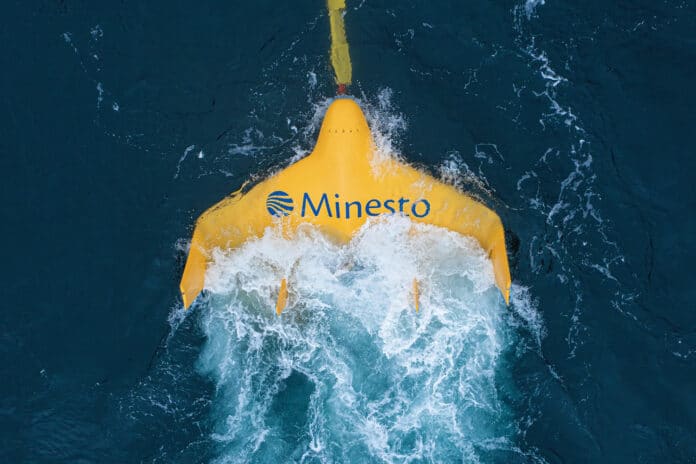Renewable energy firm Minesto has reached a key milestone – its first utility-scale tidal powerplant, Dragon 12, rated at 1.2 MW, successfully delivered its first electricity to the national grid of the Faroe Islands in the early morning of 9 February 2024.
The Saab spinoff firm has achieved a major milestone with the launch and recovery method of their Dragon 12 tidal kite technology. This is a significant step forward in their goal to provide ocean-based power generation solutions that are clean, dependable, and cost-effective.
Minesto’s Dragon 12 tidal energy kite is now generating electricity at satisfactory levels in its first phase of operation. The Dragon 12 – a scaled-up version of Minesto’s 2.5-ton Dragon 4 – is Minesto’s first tidal energy kite on a megawatt scale. Measuring 12 meters wide and weighing 28 tons, the Dragon 12 needs to be disassembled to fit in a shipping container.
Anchored to the seabed via a rope, this subsea kite is steered in an 8-shaped flight trajectory powered by the tidal flow. It is a 10-times scale-up from the existing 100 kW Dragon 4, delivering competitive performance and cost levels for the build-out of large-scale commercial subsea parks of tidal powerplants.
The Dragon 12 tidal powerplant is a significant advancement from its predecessor, Dragon 4, boasting a 10x increase in scale with a capacity of 1 MW. Thanks to its competitive performance and cost efficiency, this innovation paves the way for large-scale commercial subsea parks of tidal power plants.
The methodology devised for Dragon 4 required no adjustments when implemented for Dragon 12, as demonstrated the successful LARS procedure conducted in the Faroe Islands. Despite being ten times heavier, three times larger, and utilizing a longer rope, the Dragon 12 can still be accommodated by the existing LARS protocol.
In addition, its capacity to operate at greater water depths amplifies its versatility. This approach has validated the efficacy of the project and instilled confidence in its viability. Both tidal streams and ocean currents primarily comprise low-flow currents, which means that first-generation tidal technologies require strong tidal flows with specific installation depths for commercial viability.
Minesto’s Kite System technology is a lightweight, flexible, and scalable solution designed for tapping tidal energy. It is considered a dependable renewable energy source as it harnesses energy from tidal streams and ocean currents, which are more reliable than solar and wind power.
The Dragon tidal kite power plant comprises a wing that houses a turbine that’s directly linked to a generator within a nacelle. The kite’s trajectory is managed through rudder and elevator manipulation, and controlled by a sophisticated system. The tether secures the kite and carries communication and power lines that are connected to the seabed foundation using a simple, lockable mechanism.
Upon deployment, the turbine shaft powers the generator, sending electricity to the grid via a cable in the rope and a seabed umbilical running to the coast. Minesto’s subsea kite is engineered to fly against the main flow, achieving a relative speed several times faster than stationary turbines. This design reduces the required size and rotor, which in turn reduces installation, operational, and maintenance costs, making it a more economical choice for tidal power generation.
“This is a big day for Minesto. We have reached the most significant milestone in the history of the company by producing electricity for the grid with our megawatt-scale powerplant. We are both proud and happy and more than ever look forward to the journey ahead,” said Dr Martin Edlund, CEO of Minesto.
“What the Minesto team has achieved today is extraordinary and set a new agenda for renewable energy build-out in many areas of the world. The competitiveness of the Dragon 12 is straight to the point; it’s powerful, cost-effective, and feeds predictable electricity to the grid,” said Dr Martin Edlund.
